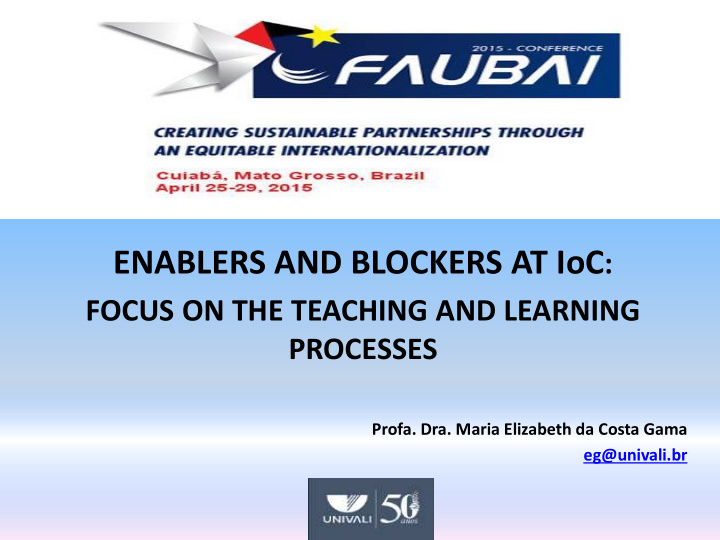



ENABLERS AND BLOCKERS AT IoC : FOCUS ON THE TEACHING AND LEARNING PROCESSES Profa. Dra. Maria Elizabeth da Costa Gama eg@univali.br
INTRODUCING MYSELF AND UNIVALI
UNIVALI’S INTERNATIONALIZATION Start of the process: PROCESS 1 Creation of the 2 Approval of the International Office 2 9 Plan for the 0 Start of Student Mobility Development of 9 0 0 Program – PIA (1st partner the Consolidation 2 1 UMinho, Portugal) Intrnationalization 1 of cooperation Process (PDPI) 1 - network MOU signed with many - universities in countries in 2 Introduction of Strategic Europe and South America 2 strategic actions Partnerships - 0 0 Programs for Faculty outlined in the 0 2 Mobility PDPI 0 0 0 Increase of cooperation Approval of the 4 network 1 internationalization policy 5
UNIVALI’S PDPI 3 Dimensions Student Mobility Faculty Mobility Internationalization of curriculum
The CIGE Model for Comprehensive Internationalization
WHERE WE ARE TODAY Student mobility (since 1992): Outbound: 745 Inbound: 383 Faculty mobility (last 3 years): Outbound: 76 Incoming: 124 Double Diploma: - University of Alicante - Universitá Degli Studi di Perugia - University of Coimbra -University of Minho -University of Aveiro
UNIVALI IN THE WORLD
INTERNATIONAL STUDENTS
UNDERGRADUATE EXCHANGE STUDENTS
MOTIVATION Every class (on campus or abroad) should prepare students to develop knowledge, abilities and attitudes which could enable them to live and work successful and harmoniously in the 21st century society.
IoC/IaH is an essential component of internationalization of higher education of relevance to all staff and students ;
IoC/IaH the incorporation of an international and intercultural dimension into preparation, delivery and outcomes of a program of study ( Leask 2009); a dynamic, ongoing, interactive process aimed transforming attitudes, skills and knowledge for effective communication across cultures and contexts ( Freeman et al, 2008);
INTERNATIONALIZATION AT HOME- IaH Approaching linguitic competence, diversity, multicultural education, inclusive curriculum and other activities that promote an international dimension at home. Thinking globally while living locally
International disciplines: Biopsychosocial Aspects of Pain: Comprehension and Treatment Brazilian and Regional Culinary Brazilian Architecture Brazilian Biodiversity: Plants, their Uses and Application in Foods, Cosmetics and Medicines Broadcasting Journalism Global Markets and Negotiation History and Cultural Patrimony Integracion Regional Culturas y Nuevos Mercados Intercultural Communication Major Brazilian Tropical Diseases Marketing Marketing Aspects in the Brazilian Consumer Behaviour Negociaciones Internacionales Principles of Environmental Sciences and Technology Society and Culture
COMPREHENSIVE INTERNATIONALIZATION ANSWERS Why are we doing this? • Preparing students for global citizenship; • Making students more competitive in the global marketplace; • Enhancing institutional reputation and competitive position; • Enhancing the research agenda; • Strengthening engagement that promotes the application of knowledge; • Making a better, more understanding world;
MAIN PROBLEM !
HOW TO SOLVE IT? By Listening to the voices of the agents involved in the IoC pilot workshop( 201O) delivered at the course of Foreign Trade;
2010 PILOT IoC WORKSHOP
2010 PILOT IoC WORKSHOP
HOW DID I Do IT ? By carrying out a 3h- guided Interview followed by open questions , with: FACULTY ( 6/ 12), COORDINATOR (1); TEACHING STAFF(0/3); VICE-RECTOR FOR TEACHING (1); ‘TEACHER TRAINER’ (1)
OPEN QUESTIONS Did your revise your course plan (syllabus) so as to infuse the international and intercultural perspectives? Do you usually do it before the beginning of every academic semester? What are the main blockers and enablers ?
ENABLERS “There is a very clear understanding that internationalization is an interesting and necessary process [...] there is a desire to make it happen ...”
ENABLERS “ Most professors in the course are really motivated ... They know how important it is for our students ...” ;
ENABLERS ‘The idea of internationalization was clearly understood ... We left the workshop very happy because we could certainly do that ... It was easy...’
ENABLERS “ There is a lot of support from the coordination of the course; After the workshop, Prof. Jorge helped us look over our course plan... Objectives, pedagogical strategies, references … Even now he is in another course, goes on doing it in an informal way. ’’
ENABLERS “ Institutional willingness to place internationalization in its strategic planning is a reality…”
BLOCKERS “Professors seem to fear what is new and unknown. So they resist the process…”
BLOCKERS IoC is misinterpreted as classes to be taught in English , and that is not the case.
BLOCKERS Professionals are increasingly seeking such training .. I missed workshops aimed at a better understanding of l the English language ... The internationalization is a process that we all seek to be engaged ."
BLOCKERS “Professors are not willing to leave their comfort zones; therefore, they must be guided and required (forced) to do things”.
BLOCKERS “Lack of preparation for teaching is the greatest barrier to the internationalization of the curriculum ... the greatest difficulty in higher education in general ... a very great challenge for our teachers .
BLOCKERS “Mastering technical knowledge is not enough … it is necessary know how to teach. ... the greatest difficulty is the lack of knowledge that teachers have about the very act of teaching ."
BLOCKERS “it seems that there are two spaces: one for the people responsible for the IoC process, and another one for professors”;
BLOCKERS “I often miss the opportunity of providing students with references and materials in a foreign language for lack of knowledge .. I speak for myself and also( what I know about) the experience of other colleagues…”
BLOCKERS “ How to present the student with references in another language, if the teacher himself is not prepared for that ? So, the language may be both an enabler and a blocker”.
BLOCKERS ‘ The process of internationalization faces resistance within the institution itself ... It is relegated to the background; if there is another important the need, it will surely lose its place in the list of institutional priorities’
SOME PRELIMINARY RESULTS
SO NICE BEING WITH YOU IN CUIABÁ!
Recommend
More recommend